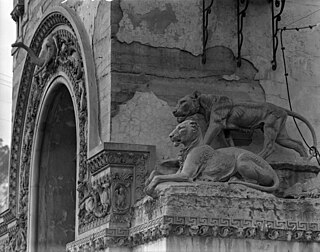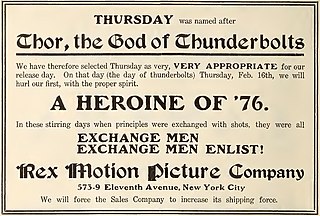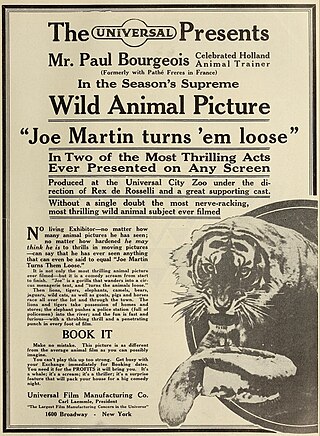
Forest Lawn Memorial Park – Hollywood Hills is one of the six Forest Lawn cemeteries in Southern California. It is located at 6300 Forest Lawn Drive, Los Angeles, California 90068, in the Hollywood Hills neighborhood of Los Angeles.

Carl Laemmle was a German-American film producer and the co-founder and, until 1934, owner of Universal Pictures. He produced or worked on over 400 films.

Universal City is an unincorporated area within the San Fernando Valley region of Los Angeles County, California, United States. Approximately 415 acres (1.7 km2) within and around the surrounding area is the property of Universal Pictures, one of the five major film studios in the United States: about 70 percent of the studio's property is inside this unincorporated area, while the remaining 30 percent is within the Los Angeles city limits. Universal City is primarily surrounded by Los Angeles with its northeastern corner touching the city of Burbank, making the unincorporated area a county island.


The Independent Moving Pictures Company (IMP) was a motion picture studio and production company founded in 1909 by Carl Laemmle. The company was based in New York City, with production facilities in Fort Lee, New Jersey. In 1912, IMP merged with several other production companies to form Universal Film Manufacturing Company, later re-named Universal Pictures Company with Laemmle as president.
A movie ranch is a ranch that is at least partially dedicated for use as a set in the creation and production of motion pictures and television shows. These were developed in the United States in southern California, because of the climate. The first such facilities were all within the 30-mile (48 km) studio zone, often in the foothills of the San Fernando Valley, Santa Clarita Valley, and Simi Valley in the U.S. state of California.
Edendale is a historical name for a district in Los Angeles, California, northwest of Downtown Los Angeles, in what is known today as Echo Park, Los Feliz and Silver Lake. In the opening decades of the 20th century, in the era of silent movies, Edendale was known as the home of most major movie studios on the West Coast. Among its many claims, it was home to the Keystone Kops, and the site of many movie firsts, including Charlie Chaplin's first movie, the first feature-length comedy, and the first pie-in-the-face. The Edendale movie studios were mostly concentrated in a four-block stretch of Allesandro Street, between Berkeley Avenue and Duane Street. Allesandro Street was later renamed Glendale Boulevard.

The Selig Zoo in Los Angeles, California was an early 20th century animal collection managed by Col. W.N. Selig for use in Selig Polyscope Company films and as a tourist attraction. Over the years the zoo was also known as the Luna Park Zoo, California Zoological Gardens, Zoopark, and, eventually, Lincoln Amusement Park. After Westerns, "animal pictures" were Selig's second-most popular genre of film product.
Rex De Rosselli, was an American actor of the silent era, mainly appearing in Westerns. He appeared in more than 150 films between 1911 and 1926. He was born in Kentucky and died in East Saint Louis. He also served as head trainer of the Universal City Zoo from approximately 1915 to 1917. Rex De Rosselli was described as a "silver-haired Beau Brummell" who alternated film work in the winters and circus work in the summers.
The Centaur Film Company was an American motion picture production company founded in 1907 in Bayonne, New Jersey, by William and David Horsley. It was the first independent motion picture production company in the United States. In 1909 the company added a West Coast production unit, the Nestor Film Company, which established the first permanent film studio in Hollywood, California, in 1911. The company was absorbed by the Universal Film Manufacturing Company in 1912.

The history of the San Fernando Valley from its exploration by the 1769 Portola expedition to the annexation of much of it by the City of Los Angeles in 1915 is a story of booms and busts, as cattle ranching, sheep ranching, large-scale wheat farming, and fruit orchards flourished and faded. Throughout its history, settlement in the San Fernando Valley was shaped by availability of reliable water supplies and by proximity to the major transportation routes through the surrounding mountains.

The Moving Picture World was an influential early trade journal for the American film industry, from 1907 to 1927. An industry powerhouse at its height, Moving Picture World frequently reiterated its independence from the film studios.

The Champion Film Company was an independent production company founded in 1909 by Mark M. Dintenfass. The studio was one of the film companies that merged to form Universal Pictures.

Rex Motion Picture Company was an early film production company in the United States.

The Unattainable is a 1916 American Blank and White silent drama directed by Lloyd B. Carleton. The film is based on the story by Elwood D. Henning. The photoplay stars Dorothy Davenport and Emory Johnson.

Universal City Zoo was a private animal collection in southern California that provided animals for silent-era Universal Pictures adventure films, circus pictures, and animal comedies, and to "serve as a point of interest" for tourists visiting Universal City. The animals were also leased to other studios. The zoo was closed in 1930, after cinema's transition to synchronized sound complicated the existing systems for using trained animals onscreen.

Joe Martin Turns 'Em Loose is a two-reel black-and-white silent comedy film released by Universal Pictures on September 15, 1915. It is not found in the Library of Congress' film preservation database and as such, is believed to be a lost film. The film was regarded by contemporary reviewers as a remarkable for its integration of plot, animal performance and stuntwork. The film’s animals were the trained tigers of Paul Bourgeois paired with the menagerie of the recently established Universal City Zoo, under the leadership of Rex De Rosselli. Bourgeois was the director and scenarist.

Algernon Maltby "Curley" Stecker was an early Hollywood animal trainer, Universal City Zoo superintendent, animal-film producer, and occasional actor-stuntman.

Charlie, sometimes Charley or Old Charlie, was an elephant who lived at the Universal City Zoo in Universal City, California, United States, from approximately 1914 to 1923 and appeared in scores of silent-era films. He was executed in approximately August 1923 for his attack on trainer Curley Stecker.

Otto F. Breitkreutz, universally known as Big Otto, was an American circus man and film producer during the early 20th century. He was called Big Otto because he weighed somewhere between 350–480 lb (160–220 kg) and was "big in heart and policy."


















